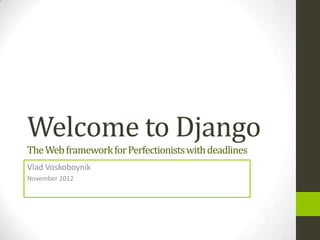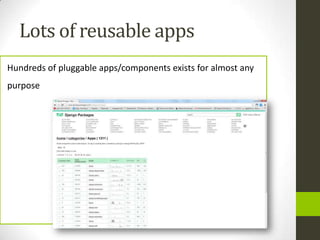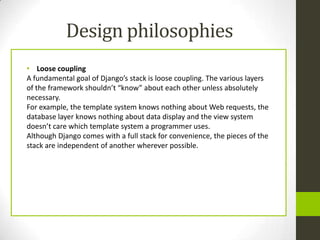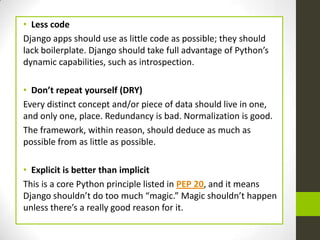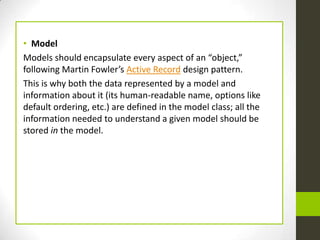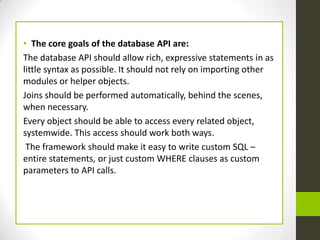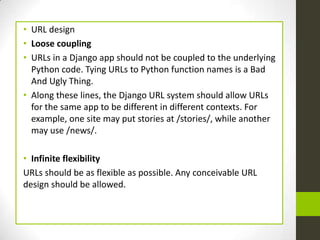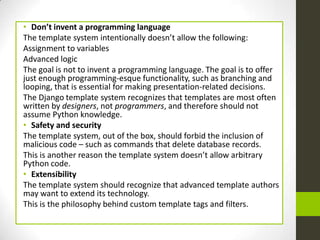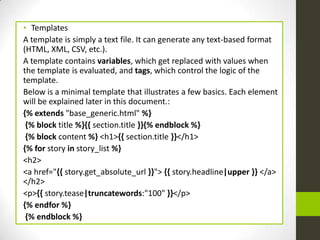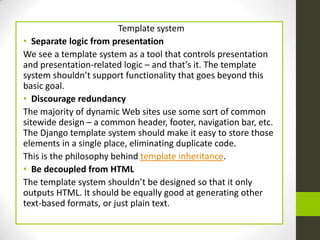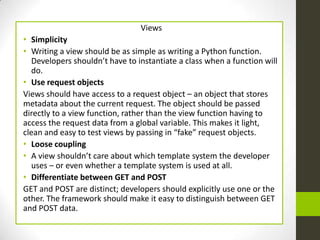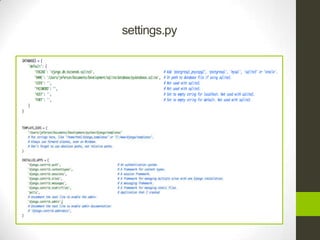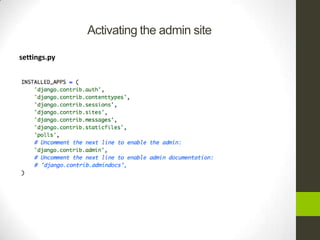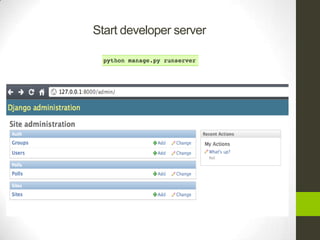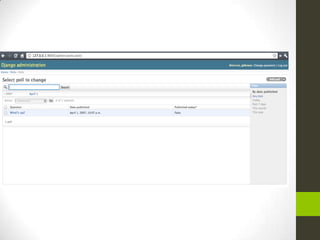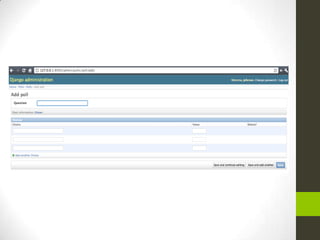Introduction to django
- 1. Welcome to Django The Web framework for Perfectionists with deadlines Vlad Voskoboynik November 2012
- 2. Introduction to Django ŌĆó Leading Python Web Framework ŌĆó Good for any service, not just Web apps
- 3. Why for Perfectionists? ŌĆó Emphasizing clean MVC design ŌĆó Django apps are reusable by design ŌĆō DRY Principle ŌĆó Extremely easy to unit-test
- 4. Key Features ŌĆó ORM ŌĆó Caching ŌĆó Admin ŌĆó I18N ŌĆó URLŌĆÖs design ŌĆó Middleware ŌĆó Authentication ŌĆó Unit testing ŌĆó Template engine ŌĆó Integrated GIS ŌĆó Reusable apps
- 5. Lots of reusable apps Hundreds of pluggable apps/components exists for almost any purpose
- 6. How do you develop/run? ŌĆó Any IDE (vim, Eclipse, PyCharm etc.) ŌĆó Django runs on Linux, Apache/NGINX, MySQL/Postgress, Python
- 7. Design philosophies ŌĆó Loose coupling A fundamental goal of DjangoŌĆÖs stack is loose coupling. The various layers of the framework shouldnŌĆÖt ŌĆ£knowŌĆØ about each other unless absolutely necessary. For example, the template system knows nothing about Web requests, the database layer knows nothing about data display and the view system doesnŌĆÖt care which template system a programmer uses. Although Django comes with a full stack for convenience, the pieces of the stack are independent of another wherever possible.
- 8. ŌĆó Less code Django apps should use as little code as possible; they should lack boilerplate. Django should take full advantage of PythonŌĆÖs dynamic capabilities, such as introspection. ŌĆó DonŌĆÖt repeat yourself (DRY) Every distinct concept and/or piece of data should live in one, and only one, place. Redundancy is bad. Normalization is good. The framework, within reason, should deduce as much as possible from as little as possible. ŌĆó Explicit is better than implicit This is a core Python principle listed in PEP 20, and it means Django shouldnŌĆÖt do too much ŌĆ£magic.ŌĆØ Magic shouldnŌĆÖt happen unless thereŌĆÖs a really good reason for it.
- 9. ŌĆó Model Models should encapsulate every aspect of an ŌĆ£object,ŌĆØ following Martin FowlerŌĆÖs Active Record design pattern. This is why both the data represented by a model and information about it (its human-readable name, options like default ordering, etc.) are defined in the model class; all the information needed to understand a given model should be stored in the model.
- 10. ŌĆó The core goals of the database API are: The database API should allow rich, expressive statements in as little syntax as possible. It should not rely on importing other modules or helper objects. Joins should be performed automatically, behind the scenes, when necessary. Every object should be able to access every related object, systemwide. This access should work both ways. The framework should make it easy to write custom SQL ŌĆō entire statements, or just custom WHERE clauses as custom parameters to API calls.
- 11. ŌĆó URL design ŌĆó Loose coupling ŌĆó URLs in a Django app should not be coupled to the underlying Python code. Tying URLs to Python function names is a Bad And Ugly Thing. ŌĆó Along these lines, the Django URL system should allow URLs for the same app to be different in different contexts. For example, one site may put stories at /stories/, while another may use /news/. ŌĆó Infinite flexibility URLs should be as flexible as possible. Any conceivable URL design should be allowed.
- 12. ŌĆó DonŌĆÖt invent a programming language The template system intentionally doesnŌĆÖt allow the following: Assignment to variables Advanced logic The goal is not to invent a programming language. The goal is to offer just enough programming-esque functionality, such as branching and looping, that is essential for making presentation-related decisions. The Django template system recognizes that templates are most often written by designers, not programmers, and therefore should not assume Python knowledge. ŌĆó Safety and security The template system, out of the box, should forbid the inclusion of malicious code ŌĆō such as commands that delete database records. This is another reason the template system doesnŌĆÖt allow arbitrary Python code. ŌĆó Extensibility The template system should recognize that advanced template authors may want to extend its technology. This is the philosophy behind custom template tags and filters.
- 13. ŌĆó Templates A template is simply a text file. It can generate any text-based format (HTML, XML, CSV, etc.). A template contains variables, which get replaced with values when the template is evaluated, and tags, which control the logic of the template. Below is a minimal template that illustrates a few basics. Each element will be explained later in this document.: {% extends "base_generic.html" %} {% block title %}{{ section.title }}{% endblock %} {% block content %} <h1>{{ section.title }}</h1> {% for story in story_list %} <h2> <a href="{{ story.get_absolute_url }}"> {{ story.headline|upper }} </a> </h2> <p>{{ story.tease|truncatewords:"100" }}</p> {% endfor %} {% endblock %}
- 14. Template system ŌĆó Separate logic from presentation We see a template system as a tool that controls presentation and presentation-related logic ŌĆō and thatŌĆÖs it. The template system shouldnŌĆÖt support functionality that goes beyond this basic goal. ŌĆó Discourage redundancy The majority of dynamic Web sites use some sort of common sitewide design ŌĆō a common header, footer, navigation bar, etc. The Django template system should make it easy to store those elements in a single place, eliminating duplicate code. This is the philosophy behind template inheritance. ŌĆó Be decoupled from HTML The template system shouldnŌĆÖt be designed so that it only outputs HTML. It should be equally good at generating other text-based formats, or just plain text.
- 15. Views ŌĆó Simplicity ŌĆó Writing a view should be as simple as writing a Python function. Developers shouldnŌĆÖt have to instantiate a class when a function will do. ŌĆó Use request objects Views should have access to a request object ŌĆō an object that stores metadata about the current request. The object should be passed directly to a view function, rather than the view function having to access the request data from a global variable. This makes it light, clean and easy to test views by passing in ŌĆ£fakeŌĆØ request objects. ŌĆó Loose coupling ŌĆó A view shouldnŌĆÖt care about which template system the developer uses ŌĆō or even whether a template system is used at all. ŌĆó Differentiate between GET and POST GET and POST are distinct; developers should explicitly use one or the other. The framework should make it easy to distinguish between GET and POST data.
- 16. ŌĆó Middleware Middleware is a framework of hooks into DjangoŌĆÖs request/response processing. ItŌĆÖs a light, low-level ŌĆ£pluginŌĆØ system for globally altering DjangoŌĆÖs input or output. Each middleware component is responsible for doing some specific function. For example, Django includes a middleware component, TransactionMiddleware, that wraps the processing of each HTTP request in a database transaction. Django ships with some built-in middleware you can use right out of the box. ŌĆó Activating middleware To activate a middleware component, add it to the MIDDLEWARE_CLASSES tuple in your Django settings. In MIDDLEWARE_CLASSES, each middleware component is represented by a string: the full Python path to the middlewareŌĆÖs class name. For example, hereŌĆÖs the default value created by django-admin.py startproject: MIDDLEWARE_CLASSES = ( 'django.middleware.common.CommonMiddleware', 'django.contrib.sessions.middleware.SessionMiddleware', 'django.middleware.csrf.CsrfViewMiddleware', 'django.contrib.auth.middleware.AuthenticationMiddleware', 'django.contrib.messages.middleware.MessageMiddleware', )
- 17. Creating a project What startproject created ? Development server: Python manage.py runserver
- 19. settings.py
- 20. Creating APP
- 21. Model
- 22. Playing with the API
- 24. Activating the admin site settings.py
- 25. Activating the admin site urls.py

